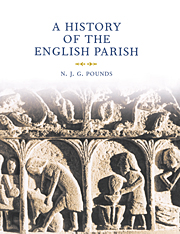Book contents
- Frontmatter
- Contents
- List of illustrations
- Preface
- List of abbreviations
- PART I THE ORIGINS OF THE PAROCHIAL SYSTEM
- 1 Church and parish
- 2 Rectors and vicars: from Gratian to the Reformation
- 3 The parish, its bounds and its divison
- 4 The urban parish
- PART II THE FUNCTIONS OF THE PARISH
- PART III THE PARISH AND ITS CHURCH
- Notes
- Index
2 - Rectors and vicars: from Gratian to the Reformation
Published online by Cambridge University Press: 29 July 2009
- Frontmatter
- Contents
- List of illustrations
- Preface
- List of abbreviations
- PART I THE ORIGINS OF THE PAROCHIAL SYSTEM
- 1 Church and parish
- 2 Rectors and vicars: from Gratian to the Reformation
- 3 The parish, its bounds and its divison
- 4 The urban parish
- PART II THE FUNCTIONS OF THE PARISH
- PART III THE PARISH AND ITS CHURCH
- Notes
- Index
Summary
Too often we allow ourselves to suppose that
could we but get back to the beginning we should
find that all was intelligible and should then be able
to watch the process whereby simple ideas were
smothered under subtleties and technicalities. But it
is not so. Simplicity is the outcome of technical subtlety;
it is the goal not the starting point. As we go backwards
the familiar outlines become blurred; the ideas become
fluid, and instead of the simple we find the indefinite.
F. W. MaitlandThe eleventh and twelfth centuries were a period of reform within the church. Not only did they see the creation of new religious orders and the foundation of an immense number of religious houses, they were characterised also by the elaboration of canon law and by an attempt on the part of the church – in the main successful – to rid itself of every vestige of secular control. On the highest plane the church fought with the lay power in the Investiture Conflict for the right to choose and invest its own bishops, and, at lower level, it set its face against the control which lay patrons continued to exercise over both the appointment of priests and the incomes of their patronal churches.
The parochial system, as it had evolved both in England and over much of western Europe, had many defects in the eyes of the church.
- Type
- Chapter
- Information
- A History of the English ParishThe Culture of Religion from Augustine to Victoria, pp. 41 - 66Publisher: Cambridge University PressPrint publication year: 2000



